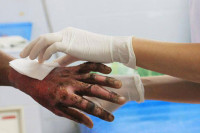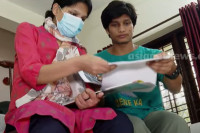Health
High-containment unit set up at National Lab, Teku
Officials say the unit built with WHO support can neutralise highly infectious viruses and boost Nepal’s ability to prevent future outbreaks.
Post Report
The National Public Laboratory (NPHL) has set up a high-containment unit, a facility designed to prevent the risk of highly contagious viruses spilling over into communities.
The new high-containment unit has laboratory facilities that help in neutralising highly infectious viruses such as SARS-COV-2, Ebola, MERS, Nipah, and Marburg, among others, according to officials at the laboratory, also known as the central lab.
The unit will also support research in various areas like pathology, immunology, and microbiology.
“Now we can neutralise highly infectious diseases in our own lab,” said Dr Ranjan Raj Bhatta, director at the laboratory. “Samples of viruses need to be neutralised before sending them for testing abroad or within our own laboratory to prevent the risk of spillover.”
Like many countries, Nepal is highly vulnerable to the spread of deadly diseases due to increased global movement. Experts have warned that any disease seen in any corner of the world can enter the country, as thousands of people from around the globe enter the country every day.
Infections from several deadly viruses, including SARS-COV-2, mpox, Chandipura virus, and swine flu, have been confirmed in the past. The country also reported a human death from avian flu in 2019.
In most cases, swab samples of the suspects were sent to the World Health Organisation’s collaborating centres abroad—Japan, Hong Kong, India, Thailand, and London—for confirmation.
“Due to the global movement of people, we are a high-risk country,” said Dr Sher Bahadur Pun, chief of the Clinical Research Unit at Sukraraj Tropical and Infectious Disease Hospital. “The swine flu virus was detected in our country within two weeks of its outbreak in South America.”
Experts say infected people can enter the country during the incubation period of the virus’s infection and spread the deadly disease in communities while health authorities remain unaware of the infection.
Pun added that Nepal is also at risk of several other infectious diseases, such as Ebola and Nipah viruses, due to the frequent movement of people between Nepal and countries on the African continent.
“Along with strengthening laboratory facilities and training health workers, authorities must step up surveillance measures to lessen the risk of outbreaks of deadly diseases,” said Pun.
Meanwhile, the NPHL officials say that the World Health Organisation has provided financial and technical support to set up the facility through its pandemic fund. Around Rs40 million was spent to set up the facilities
“We witnessed the coronavirus pandemic in the recent past. A similar or a more severe outbreak could occur at any time,” said Bhatta. “Setting up a high-containment unit at the central laboratory is part of our preparedness for possible outbreaks.”
The unit is of a level-3 category, which is a sealed facility having all containment measures.
Along with financial and technical help for the high-containment unit, the UN health body has also provided various equipment and testing kits for provincial laboratories and laboratories at district hospitals.
The WHO also provided financial and technical help in the past to set up a biosafety level-3 laboratory at the NPHL. Along with providing lab services, the NPHL also regulates the quality of laboratories in the country.




 17.12°C Kathmandu
17.12°C Kathmandu












%20(1).jpg&w=300&height=200)
